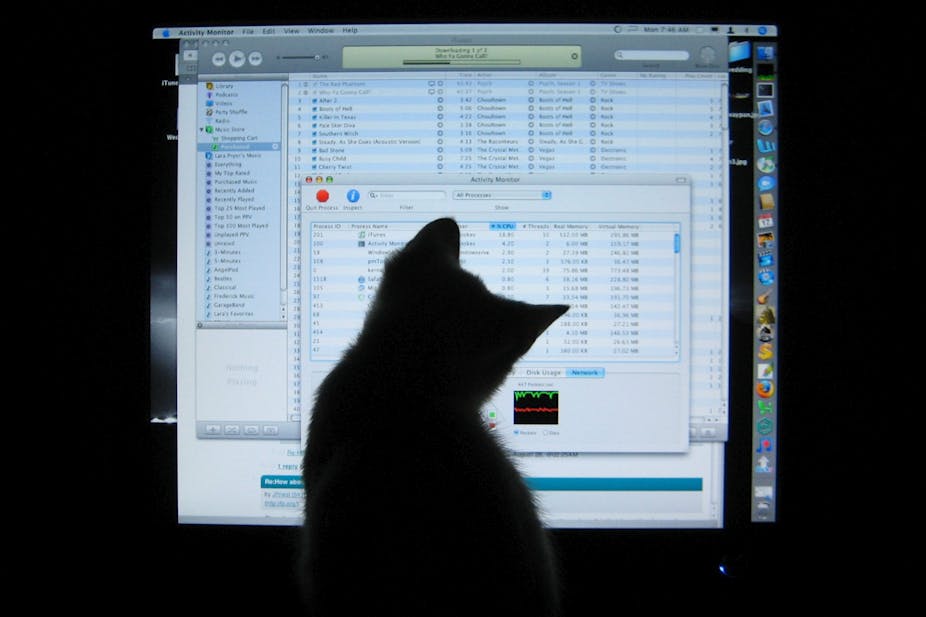Each year the Macquarie Dictionary names a Word of the Year from a shortlist of words that have made a valuable contribution to the language. And it has declared 2013 to be the year … of … the … “infovore”.
The Macquarie defines an infovore as “a person who craves information, especially one who takes advantage of their ready access to it on digital devices”.
Infovore’s selection complements similar technologically-influenced word of the year choices in Britain (the Oxford English Dictionary chose “selfie”) and the US (the American Dialect Society chose the usage “because x”).
Many decry the influence of technology on language. For critics, terms such as infovore, and other terms nominated for the Macquarie word of the year such as “ping”, “showrooming”, and “yolo” dwell on that part of the linguistic map labelled “here be dragons”.
Should we be worried?
No, “infovore”, “selfie” and “because x” are simply examples of healthy linguistic dynamism and notably similar to language change across the ages.
Infovore and blending
The coinage of the term “infovore” is most popularly but erroneously attributed to American neuroscientists Irving Biederman and Edward Vessel in 2006. They observed that acquiring new information about the world triggered the same pleasure mechanisms in the brain as using heroin and morphine.
While Biederman and Vessel may have popularised the term, it appeared in neuroscience literature at least three years earlier in 2003 (such as here). Infovore has also had a life independent of neuroscience literature – see, for example, this website.
Infovore results from a productive word creation process known as blending. Blending is the combination of a part or whole of one word (e.g. info-) with a part or whole of another (-vore).

Blends or portmanteaus are often playful and ephemeral. For instance, brunch (a blend of breakfast and lunch) emerged in the early 20th century to refer facetiously to the meal eaten by those too lazy to wake up in time for breakfast.
Authors such as Lewis Carroll and James Joyce often used playful blends in their works.
Carroll’s blends sometimes gained traction in spoken and written English. For instance, chortle, a blend of a chuckle and snort, first appeared in Through the Looking Glass in 1871.
Blends are playful and ephemeral and this makes them a good match for the digital era. But they certainly didn’t emerge because of it.
Selfie and shortening
Selfie is the Oxford English Dictionary’s (OED) word of the year for 2013. OED research found that use of the word “selfie” had increased 17,000% from 2012 to 2013.
On the social side of things, many would note the “self”-oriented nature of the i-Generation.
But selfie’s popularity also illustrates a linguistic trend in internet language. In addition to being playful and ephemeral, it is also shortened. This is seen most saliently through many thousands of abbreviations.

However, shortenings, especially abbreviations, have been used throughout the history of English. Before the printing press, Old English and Middle English scribes used abbreviations to make their work easier and to add a bit of flair.
In fact, scribal abbreviations contributed to the later misinterpretation of “the” as “ye” and we’ve been stuck with “ye olde fish and chip shops” ever since.
Shortenings are, of course, an important part of Australian English. A postie brings our mail, a sparky takes care of our electricity and when we go swimming at our rellies’ place we wear bathers, cossies, swimmers or togs.
It should come as no surprise then that selfie is an Australian contribution to the English lexicon – the OED tracks its origin to a 2002 post in an Australian online forum.
On the one hand, shortenings such as these result from the time and space limitations of electronic media. On the other, they also function as markers of intimacy and informality in an arguably less personal medium.
In any case, they didn’t emerge “because internet” (sic), which brings me to my final point.
‘Because x’ and functional shift
The American Dialect Society in 2013 took the unusual step of naming a phrase, “because x”, as its “word” of the year.
In short, “because” functions in standard English as something known as a subordinating conjunction. It links two parts of a sentence and one part of a “because” sentence is subordinate and explains the other:
- I dislike “ye olde” chip shops (because they’ve misinterpreted abbreviated “the”).
- I dislike “ye olde” chip shops (because of the misinterpretation of the abbreviated “the”)

But there has been a shift recently in the use of “because”. It can now function as I used it above – as a preposition. Why? “Because internet.”
This is particularly the case when a speaker/ writer believes that his/ her position is obvious and an argument needn’t be made. Most such arguments could be reduced to “because logic”. The driving argument for capitalist ventures: “because money”.
As with blending and shortenings above, shifts such as these are becoming more frequent in the digital era. But they are hardly unusual in English and language more generally.
Shakespeare was a prolific and playful “verber” of other word classes (“you should safe my going”; “Lord Angelo dukes it well”).
Many languages use the same word to mark both conjunctions and prepositions. Many Malay varieties use the same word – "sama" – where English speakers would use “and” and “with”.
In sum, yes, here be infovores.
But they needn’t be feared. When it comes to language, it is just business as usual. Because language change.

